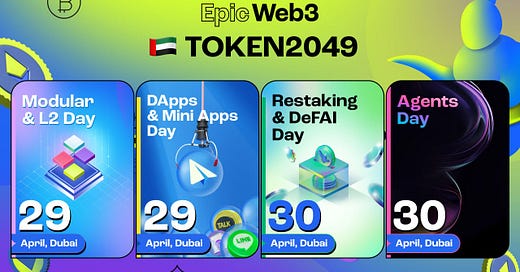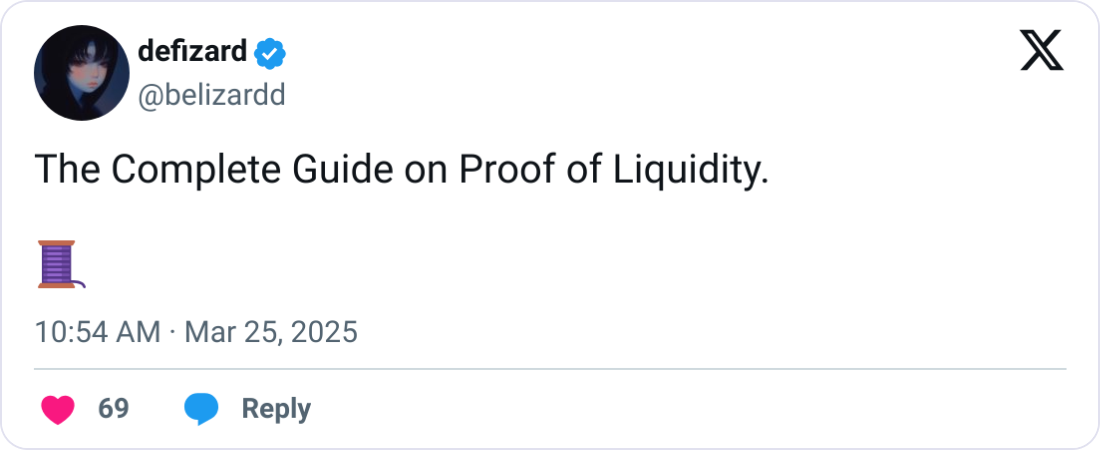Gm and happy Monday frens🖖
We have good technology. We have lots of products. Finally, we have money.
But where are the users?
Dive deep into this and why Ethereum limits us so much with Nick Dodson, co-founder of Fuel Labs!
Scroll down to see:
🗣️ Less than a month left till Token2049
🏋 The macro problems with Web3
🧵 Hyperliquid, future of identity and stablecoins
📰 Neeews
🧞♂️Epic Web3 x4 → Token2049
We're dropping not one, not two, but FOUR side events at Token2049!
Each focused on a key narrative that's reshaping the industry right now – from modular infrastructure and mini-apps to restaking primitives and autonomous agents 👇
Transforming the Web3 future with scalable L0s, rollups, cross-chain solutions, modular app-chains, chain abstraction, and seamless user onboarding.
Mass adoption blueprint: viral growth, secure mini-apps, smart fundraising, cross-platform expansion, and strategic partnerships.
Day Cross-chain dialogue on restaking and DeFAI: liquid restaking, AI-driven markets, AVSs, multi-chain strategies, and security risks.
The future of autonomous Web3: sustainable agent economies, investment in decentralized intelligence, navigating regulations, leveraging quality data, and deploying multi-agent systems.
🛠️ Deep-dive: we need Web3 magic
Fuel Ignition is a high-performance Ethereum L2, powered by the theyir own FuelVM and verifiable at home. They also have their own programming language - Sway, Rust-based, domain specific language for writing smart contracts.
We spoke with Nick Dodson, co-founder of Fuel, about the future of Web3, why we are currently struggling with infrastructure, and how we can finally get retail users on board.
The episode is truly bombastic, check it out here.
The problem with legacy infrastructure
Much of the blockchain infrastructure we use today, especially Ethereum, was not originally designed for scale or mainstream adoption. Ethereum was built fast, during a time when just getting it to function was the primary goal. As a result, many of its architectural decisions (like the EVM and account model) have become limiting factors in today’s world of more demanding applications.
From Nick's perspective, the current infrastructure layer in Web3 is still playing catch-up. Instead of optimizing for performance or user experience, it's often entangled in legacy decisions and slow governance processes. Truly transformative applications require a fresh approach — one where the tech is designed with today’s needs in mind, rather than those of 2015.
Why tech is not performative even now?
Blockchain design needs to align with how computing works today. Blockchains often ignore the basic physics of computing — like CPU cores, memory constraints, or the bandwidth between hardware components. Embracing these realities can lead to infrastructure that is actually performant and scalable.
Nick also emphasized the importance of building with flexibility in mind. Instead of being locked into rigid models or virtual machines, developers should be able to choose tools and architectures that suit their application needs — whether that’s parallel execution, stateless transaction logic, or custom asset handling. Web3 infra needs to move beyond "one-size-fits-all" design if it wants to support real-world scale.
Product-first philosophy
There is disconnect between Web3 infra and user experience. Most users don’t care about L1 vs L2, bridges, sequencers, or even decentralization in abstract — they just want the product to work well. Compare it to Slack or ChatGPT: no one cares about the stack behind the scenes, they just enjoy the project.
This signals a shift in mindset for the Web3 space. Instead of building infra for infra’s sake, the community needs to focus on building products that are delightful and intuitive. Features like instant transactions, gasless interactions, and seamless onboarding aren’t just nice-to-haves — they’re prerequisites for real adoption. IThe winning apps will be the ones where the blockchain fades into the background entirely.
Metrics that matter
Nick criticized the over-reliance on TVL and token prices as success metrics. He described them as surface-level indicators that often reward hype and speculation rather than long-term value. Instead, he advocated for focusing on daily active users, meaningful usage, and app stickiness as better indicators of product-market fit.
He also questioned the effectiveness of airdrops and incentive campaigns, suggesting that they often attract the wrong kind of users — mercenaries who are quick to move on. The Web3 ecosystem needs to get better at identifying genuine demand and encouraging sustainable growth, even if it means slower initial traction.
Big picture
At a macro level, Nick believes crypto’s most important role is enabling digital economies built on cryptographic integrity. As AI continues to grow in power, blockchains may be one of the only tools we have to ensure trust, fairness, and verifiability online. Unlike centralized systems, blockchain offers a physics-anchored truth that even the most advanced AI can’t spoof.
He also warned that Web3 is still heavily stuck in a financial loop — mostly building for speculation, not real-world value. While DeFi has proven to be a strong use case, there’s a need to go further. The next evolution will come from building useful, product-focused applications that tap into blockchain’s unique strengths — not just its financial primitives. And those apps will only emerge if the infra is ready to support them.
Learn more about Web3 macro problems with our new podcast!
🧵 What you might missed on Twitter
Get the best alpha from Web3 Twitter, without scrolling aimlessly for hours.
Just click on the tweet to read a full version!
Will Jelly destroy Hyperliquid?
Overview of what happened.
How stablecoins are changing the finance
Some are better than other.
Web3 changing the privacy tech
No more scammers?
Guide on PoL
In case you forgot the basics (it's always nice to refresh them).
⚡ Blitz News
Coinbase & OpenSea-Backed Web3 Platform Harpie Shuts Down
SEC Drops Investigation into Web3 Gaming Firm Immutable
Google Cloud joins Injective as validator, expands Web3 tools
DWF Labs Launches Massive $250M Liquid Fund for Growing Established Web3 Proposals
All right, that’s it for today! 👋 But wait…
You didn’t say “gm” on Twitter! Let’s catch up there for daily insights.
Sending growth your way,
Epic Web3













